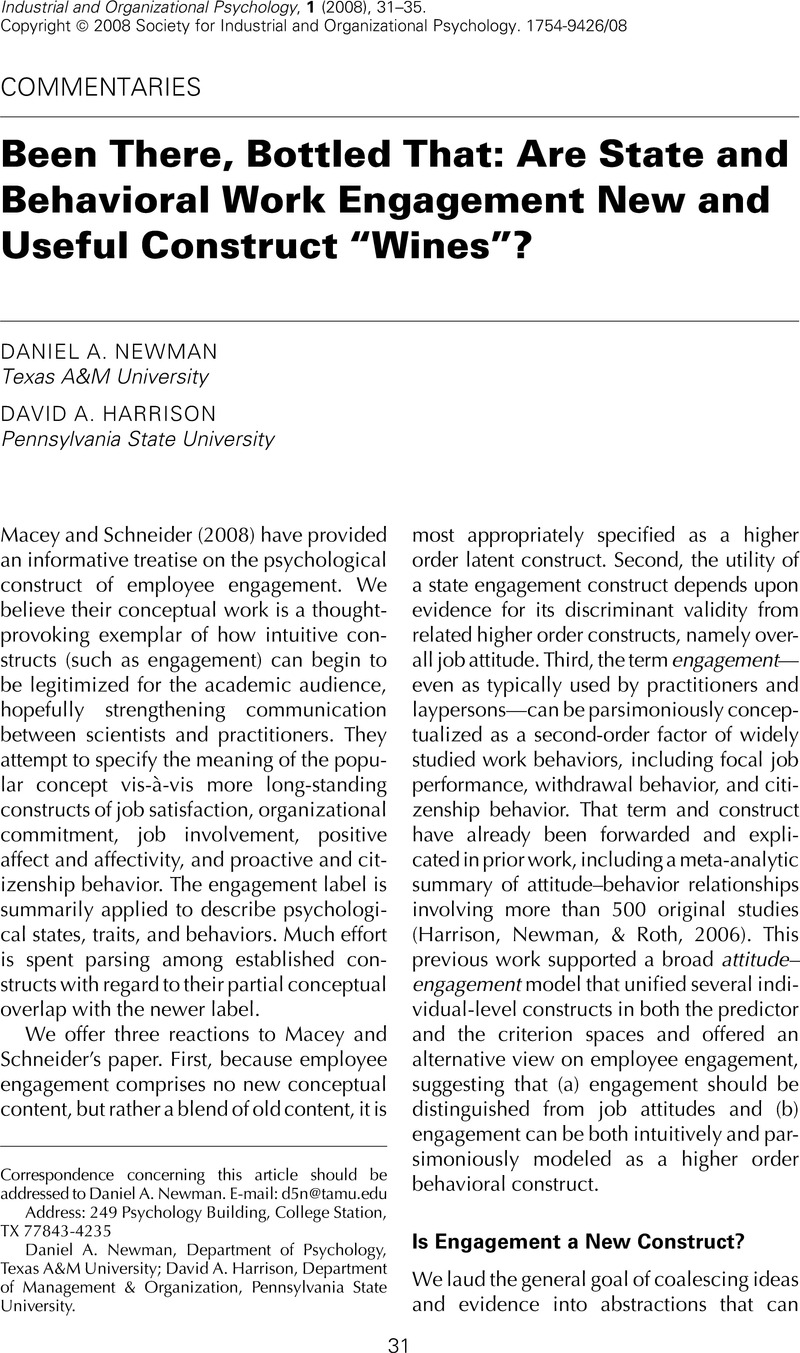Crossref Citations
This article has been cited by the following publications. This list is generated based on data provided by
Crossref.
Macey, William H.
and
Schneider, Benjamin
2008.
Engaged in Engagement: We Are Delighted We Did It.
Industrial and Organizational Psychology,
Vol. 1,
Issue. 1,
p.
76.
Zigarmi, Drea
Nimon, Kim
Houson, Dobie
Witt, David
and
Diehl, Jim
2009.
Beyond Engagement:Toward a Framework and Operational Definition for Employee Work Passion.
Human Resource Development Review,
Vol. 8,
Issue. 3,
p.
300.
NERSTAD, CHRISTINA G. L.
RICHARDSEN, ASTRID M.
and
MARTINUSSEN, MONICA
2009.
Factorial validity of the Utrecht Work Engagement Scale (UWES) across occupational groups in Norway.
Scandinavian Journal of Psychology,
p.
no.
Rich, Bruce Louis
Lepine, Jeffrey A.
and
Crawford, Eean R.
2010.
Job Engagement: Antecedents and Effects on Job Performance.
Academy of Management Journal,
Vol. 53,
Issue. 3,
p.
617.
Gruman, Jamie A.
and
Saks, Alan M.
2011.
Performance management and employee engagement.
Human Resource Management Review,
Vol. 21,
Issue. 2,
p.
123.
Shuck, Brad
and
Reio, Thomas G.
2011.
The Employee Engagement Landscape and HRD.
Advances in Developing Human Resources,
Vol. 13,
Issue. 4,
p.
419.
Saks, Alan M.
and
Gruman, Jamie A.
2011.
Getting newcomers engaged: the role of socialization tactics.
Journal of Managerial Psychology,
Vol. 26,
Issue. 5,
p.
383.
Welbourne, Theresa M.
2011.
The Future of Employment Relations.
p.
85.
Jeung, Chang-Wook
2011.
The concept of employee engagement: a comprehensive review from a positive organizational behavior perspective.
Performance Improvement Quarterly,
Vol. 24,
Issue. 2,
p.
49.
CHRISTIAN, MICHAEL S.
GARZA, ADELA S.
and
SLAUGHTER, JEREL E.
2011.
WORK ENGAGEMENT: A QUANTITATIVE REVIEW AND TEST OF ITS RELATIONS WITH TASK AND CONTEXTUAL PERFORMANCE.
Personnel Psychology,
Vol. 64,
Issue. 1,
p.
89.
Nimon, Kim
Zigarmi, Drea
Houson, Dobie
Witt, David
and
Diehl, Jim
2011.
The Work Cognition Inventory: Initial evidence of construct validity.
Human Resource Development Quarterly,
Vol. 22,
Issue. 1,
p.
7.
Saks, Alan M.
2011.
Workplace spirituality and employee engagement.
Journal of Management, Spirituality & Religion,
Vol. 8,
Issue. 4,
p.
317.
Shuck, Brad
2011.
Integrative Literature Review: Four Emerging Perspectives of Employee Engagement: An Integrative Literature Review.
Human Resource Development Review,
Vol. 10,
Issue. 3,
p.
304.
Nimon, Kim
and
Zigarmi, Drea
2011.
The Assessment of a Multinational Using the Employee Work Passion Model.
Advances in Developing Human Resources,
Vol. 13,
Issue. 4,
p.
494.
Newman, Daniel A.
Joseph, Dana L.
Sparkman, Torrence E.
and
Carpenter, Nichelle C.
2011.
Invited reaction: The Work Cognition Inventory: Initial evidence of construct validity.
Human Resource Development Quarterly,
Vol. 22,
Issue. 1,
p.
37.
VOLPONE, SABRINA D.
AVERY, DEREK R.
and
McKAY, PATRICK F.
2012.
Linkages Between Racioethnicity, Appraisal Reactions, and Employee Engagement.
Journal of Applied Social Psychology,
Vol. 42,
Issue. 1,
p.
252.
Viljevac, Adriana
Cooper-Thomas, Helena D.
and
Saks, Alan M.
2012.
An investigation into the validity of two measures of work engagement.
The International Journal of Human Resource Management,
Vol. 23,
Issue. 17,
p.
3692.
Dalal, Reeshad S.
Baysinger, Michael
Brummel, Bradley J.
and
LeBreton, James M.
2012.
The Relative Importance of Employee Engagement, Other Job Attitudes, and Trait Affect as Predictors of Job Performance.
Journal of Applied Social Psychology,
Vol. 42,
Issue. S1,
Walk, Tom
2012.
Employee Engagement: Tools for Analysis, Practice, and Competitive Advantage by William H. Macey, Benjamin Schneider, Karen M. Barbera, and Scott A. Young.
Personnel Psychology,
Vol. 65,
Issue. 1,
p.
207.
Harrison, David A.
and
Newman, Daniel A.
2012.
Handbook of Psychology, Second Edition.





